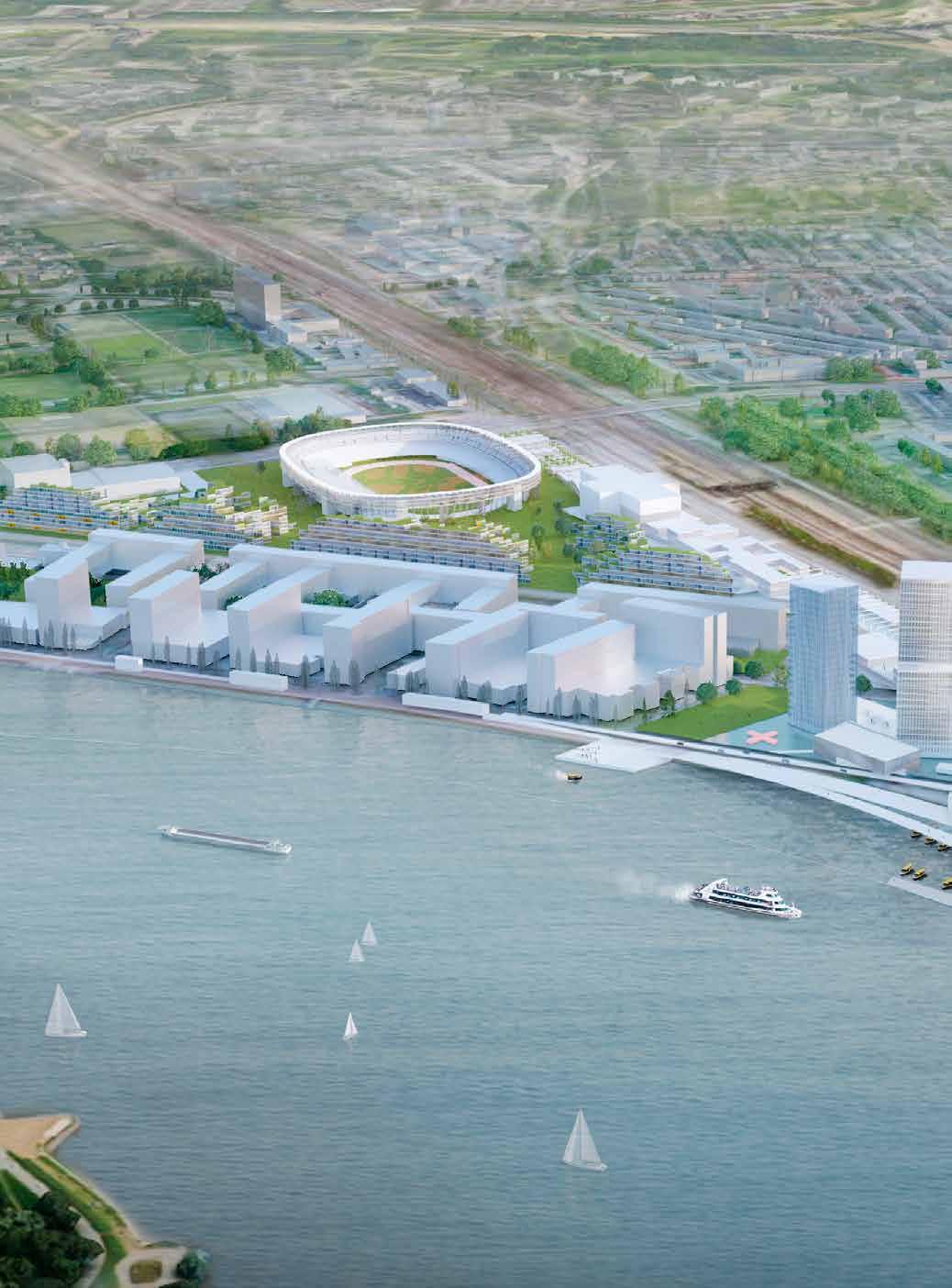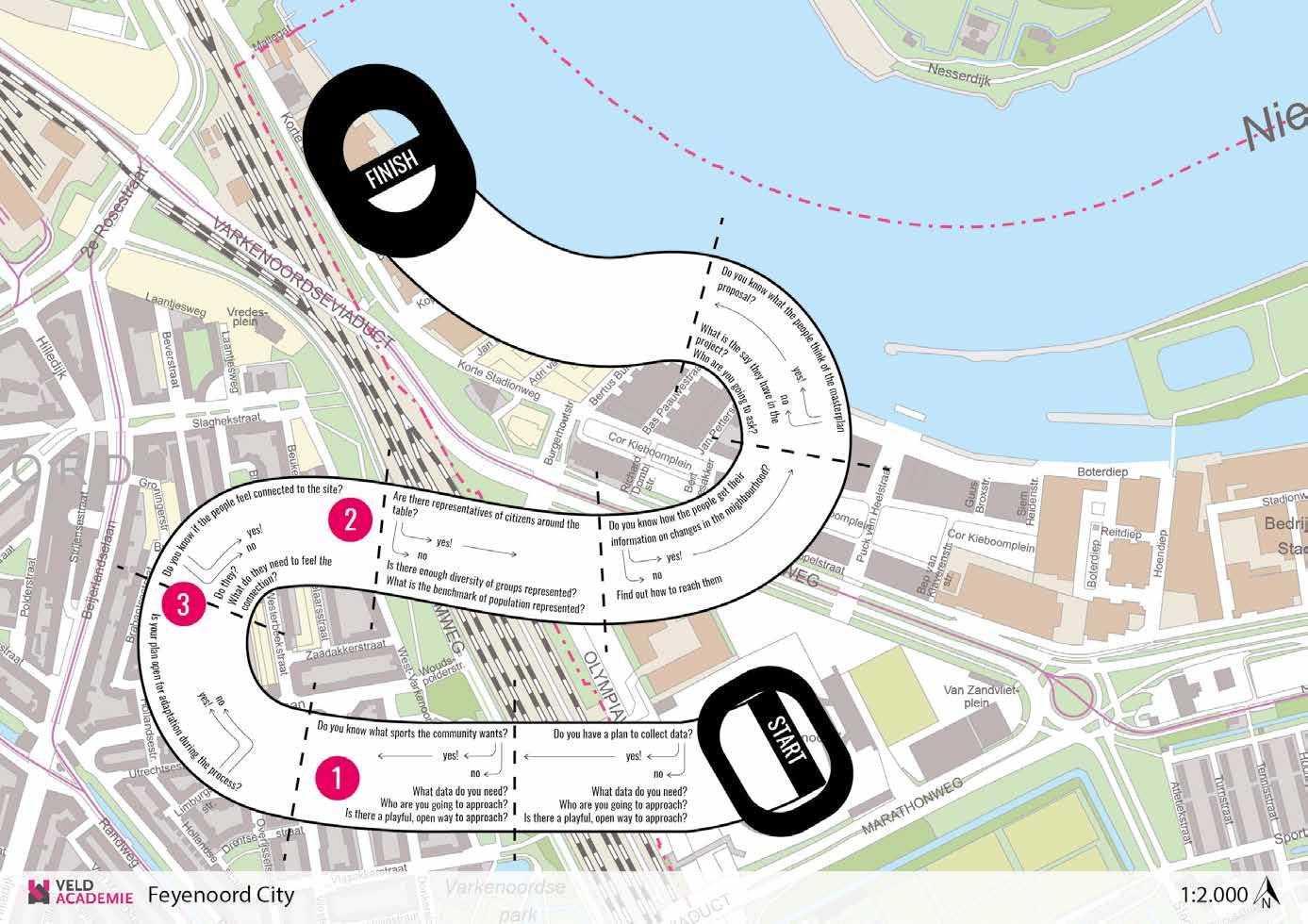
8 minute read
2.3 Feyenoord City
Proposed masterplan for Feyenoord City stadium park by OMA showing data for IJsselmonde. Source – OMA.
Feyenoord City is an area development south of the river Nieuwe Maas. Prior to the construction of the Erasmus bridge in the late ‘90s, the south of Rotterdam behaved as a separate area from the north. But the development of Kop van Zuid and the Erasmus Bridge has allowed the city centre to expand southwards. Feyenoord City has the potential to be a vibrant city centre for Rotterdam South and is creating improved connections to isolated southern neighbourhoods such as Feijenoord and IJsselmonde (OMA et al., 2016). The development could have other positive implications for these neighbourhoods, considering that the south of Rotterdam has one of the highest unemployment rates and school drop-out rates in the city. Feyenoord City is part of a large private development project initiated by the local football club Feyenoord and various project developers. The existing stadium, suitable for 50.000 visitors, is no longer able to fit the demands on the club and the neighbourhood. The plan consists of multiple components – a new stadium for 63.000 visitors, the transformation of the current stadium, housing, shops, restaurants, a hotel, leisure, entertainment and sport facilities supported by a social-economic and mobility program. The football club Feyenoord is responsible from the start to the completion of the project with the municipality of Rotterdam acting as an overseer and a facilitator.
Advertisement
The Office of Metropolitan Architecture (OMA) designed a concept masterplan in line with the municipality’s vision for the Stadiumpark, a larger area that will benefit from heavy investment in the upcoming years. The area surrounding the stadium, the Kuip Park, will offer green space for sport and leisure activities as well as residential units. The development plan also includes a socio- economic program that is required to benefit the surrounding inhabitants.
OMA has an ambitious program that includes 180.000m 2 housing; 64.000m 2 commercial space including a new cinema, restaurants, hotels, and shops and 83.000m 2 public program including a sports experience centre and addition of new sports fields. The program also features a new multi sports club for the residents of Rotterdam Zuid and will be developed in collaboration with the surrounding neighbourhoods to encourage participation in sports (OMA, 2016). With the help of relevant policy and design interventions, the development project has the potential to have a high impact on the socioeconomics of Rotterdam South.
Design for a Just City References OMA. (2016). Feyenoord City. Retrieved 6
October 2018, from http://oma.eu/projects/ feyenoord- city OMA, Tabocchini, A., Gianotten, D., Lakatos, E., Lubbers, E., Van Casteren, K., … Brown, T. (2016). Feyenoord City: Concept Masterplan Phase 2. Rotterdam: OMA.
Just • Accessible water-front • Symbols of inclusive spaces • Proposal to integrate adjacent neighbourhoods • Proposal to prioritise pedestrian movement over vehicular movement • Proposal intention of social programme and including surrounding neighbourhood
Unjust • Train tracks isolate the neighbourhood from the rest of the city • Train station only accessible during matches • Domination of vehicular movement • Poorly designed urban blocks • Proposal is only defined with the fixed borders of the Feyenoord City • Existence of social programme but has ambiguous content • Lack of representation of local needs and community in the proposal


FEYENOORD CITY MAPPING JUSTICE & INJUSTICE Source: OMA, edited by the authors Mapping of just and unjust values in the existing fabric of Feyenoord City as observed by the team.
2. MAP
Mapping justice/injustice Before the team visited Feyenoord City, existing research and data showed that the neighbourhood was very diverse. However, more than half the population fell under the low-income category, which had a negative impact on accessibility to schooling and job opportunities. When the team visited Feyenoord City, they reflected on their personal experiences and observations to map ‘just’ and ‘unjust’ features for Feyenoord City. Their first observation was that train tracks acted as physical and mental barrier while entering the site. But there was an accessible water front and access to community gardens and outdoor spaces.
38 Mapping of just and unjust values in the Masterplan proposal by OMA. MASTERPLAN OF OMA Source: OMA, edited by the authors
FEYENOORD CITY MAPPING JUSTICE & INJUSTICE
They also noted that segregated functions along the waterfront had a negative impact on the neighbourhood’ vitality. Furthermore, the OMA master-planned sough to boost vitality of the neighbourhood through a social-economic programme that would boost entrepreneurship, local innovation, etc., but a closer look showed that it lacked the design intention of integration with the surrounding neighbourhood. They also pointed out the singular focus on national and international level sports. This singularity might over power the importance of daily use and livelihoods of residents in Feyenoord city and the surrounding areas.
Authenticity Reconciliation Transparency Connectivity Agency
Just City Values for Feyenoord City
Activities designed for the sugested bridge connecting Feijenoord City and Feijnoord District.



3. ALIGN
The Site Manifesto The team deliberated that the five values important for Feyenoord City were authenticity, reconciliation, transparency, connectivity and agency. They felt that these values were missing or under-represented in the neighbourhood. This was based on their experience mapping justice and injustice in Feyenoord City. And together they formulated a written manifesto that would act as guiding
This perspective described above would help Feyenord City to be re-imagined as one that: • Is embedded in the fabric of the city. • Feels authentic, vital and will be integrated as a part of Rotterdam • Inspire each other (maybe to become contributor or stakeholder) to make the sum greater than the part • Is owned and appropriated by all people, for example, a woman with a Turkish background doing Tai-Chi, a homeless person enjoying the water-front, etc., • Provides Rotterdammers to act on behalf of their own interest.
The proposal for the Feyenoord City development project will be one where success is not only determined by money and reputation, but also by engagement and well-being of Rotterdam’s citizens.
Private developments do not need to be unjust. The perspective of a just lens recognises the diverse characteristics and needs of Rotterdam and its people. It puts the social well-being of the citizens first by enhancing physical and social networks which ties places together and provides people with contact and opportunity. It enables citizen to act on behalf of their own interests through open processes, rules, rights and procedure that share information and knowledge. It allows two sides to co-exist and different needs of various stakeholders be fulfilled and enables citizens to have a stake in the process, outcome and other assets.

Toni L. Griffin
CAPTION The Just Game developed for the municipality and developers to create a more ‘just’ process for urban growth.
4. CREATE Disruptive Design To achieve the values and ideas described in their manifesto, the team developed ‘The Just Game’ as a tool for stakeholders in Feyenoord City to guide them throughout the development process. The Just Game was supported by three design disruptions to achieve their goals. “yes” to each question. The team also wanted to include residents affected by a proposed development. The team wanted to ensure that developers or the municipality not misinterpret the needs of the community and therefore, relevant representatives should also participate in the game. Furthermore, the game could be adapted at different stages of development as a tool to engage and monitor the impact of a development. Such a format made the process of development more accessible. FEYENOORD CITY THE APPROACH
The Just Game: Extension of the Boundary A Sports Festival Disruption Play Bridge
The Just Game The game sought to raise awareness about the values important to such a project. The participants of the game could only proceed in the game if they could answer
Extension of the Boundary Through the principles of the group, it became apparent that the boundary of the masterplan is restrictive to the idea of a just city. The proposal redraws the boundaries to be more inclusive of the neighbouring communities Values addressed are: • Connectivity • Reconciliation • Agency
OMA Masterplan with redrawn borders to include the surrounding neighbourhoods of Feyenoord City.

“... you have developed a game to be played by the municipality and developer, where they ask questions like, ‘do I know what people want?’, you might run the risk of them assuming that they do know the answers, it would be good to add a third participant who would represent the community or the people... ”
Ruth Höppner
Sports Festival The sports festival addresses the values of connectivity and agency. It creates a playful framework to link community activities with the theme of sports in the agenda. The team also created flyers for the festival to address the diversity of Feyenoord City and the neighbouring communities. This would make the scheme more relatable to members of the community. It also expands the theme of ‘sports’ from the current national/ international scale football, to smaller sports that can be attractive to more groups. Values addressed are: • Connectivity • Agency
The Disruption Play Bridge On examination of the OMA proposal for Feyenoord City, the team questioned the sterile nature of infrastructure. The bridge would be a key connection between the stadium park development and the rest of the district.
The team proposed a disruption design by adding programmes to the elevated bridge like a slide, activities involving healthy eating or other more inclusive sports (like wall-climbing). Values addressed are: • Connectivity
Conclusion
The team used a value-based approach to the Feyenoord City Development to develop a new transparent and inclusive way of designing for the neighbourhood and its surroundings. The Just Game provides planners with an interesting apprach for a more inclusive process.









